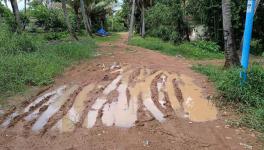Experts Link Devastating Glacial Lake Outburst in Sikkim to Climate Change

A vehicle is seen partially submerged in water after flash floods triggered by a sudden heavy rainfall swamped the Rangpo town in Sikkim, India, Thursday, Oct.5. 2023. Image Courtesy: PTI
Patna : A day after the devastating glacial lake outburst triggered flash floods in north Sikkim’s Mangan district, international climate change, cryosphere and hydrology experts expressed serious concern and linked it with climate change.
As per reports, this sudden burst also led to the breach of Sikkim’s Chungthang dam (Teesta 3 HEP), the biggest hydropower project in the state.
“Intense rain has led to this catastrophic situation in Sikkim where the rain has triggered a glacial lake outburst flood and damaged a dam and caused loss of life and caused further damage to roads and
infrastructure. We observe that such extreme events increase in frequency as the climate continues to warm and takes us into unknown territory,” said Miriam Jackson, senior cryosphere specialist, at Kathmandu-based International Centre for Integrated Mountain Development (ICIMOD), in a release.
Jakob Steiner, high mountain Asia hazards and hydrology expert and fellow of ICIMOD’s Himalaya University Consortium, said: “This is, incredibly sadly, another classic case of a cascading hazard chain that amplifies as you go downstream. It is possible that strong permafrost degradation in the vicinity of the lake may have destabilised the dam, which may have then failed upon an exceptionally strong rainfall event. Downstream, a hydropower structure was ripped away, further contributing to the massive impact that has resulted in yet more loss of life and damage to homes and infrastructure in what has been just a devastating monsoon season in the mountains of the Hindu Kush Himalaya. Tragically, what we’ve seen this summer in terms of flash floods is likely to pale in comparison with what’s to come unless we limit temperature rise.”
Pema Gyamtsho, Director General of ICIMOD, said, “Our hearts go out to everyone affected by events in Sikkim. Sadly, this is the latest in a series of deadly flash-floods that ricocheted across the Hindu Kush Himalayan region this monsoon, bringing the reality of this region’s extreme vulnerability to climate change all too vividly alive. At ICIMOD we continue to do our utmost to scale up our work to ensure communities across this region have early warnings of disasters that we know with a high degree of certainty are set to rise.”
Arun B Shrestha, a senior climate change specialist, ICIMOD, said: “We're facing a devastating flash flood in the Teesta River, Sikkim. Information is fragmented, but it appears heavy rainfall from a Bay of Bengal low-pressure depression triggered the disaster. This seems like another unfortunate example of cascading hazards. Our HIWAT application has recorded exceedingly high precipitation, exceeding 100millimetres within the last 24 hours in the vicinity.”
According to reports, scientists had warned two years ago that the South Lhonak lake in Sikkim would burst. Scientists have repeatedly said that climate change is causing an impact on Himalayan
glaciers and glacial lakes.
In 2020, ICIMOD’s research report had identified as many as 47 potentially dangerous glacial lakes (PDGLs) in Koshi, Gandaki, and Karnali river basins of Nepal, Tibet Autonomous Region of China, and
India. These glacial lakes are at risk of breaching their natural dams, which will result in glacial lake outburst floods (GLOFs).
According to the report released early this week, GLOFs are a prominent water-induced hazard in Nepal and other mountainous countries in the Hindu Kush Himalaya (HKH), and occur when melting glaciers create reservoirs of water that can suddenly burst leading to floods downstream.
Get the latest reports & analysis with people's perspective on Protests, movements & deep analytical videos, discussions of the current affairs in your Telegram app. Subscribe to NewsClick's Telegram channel & get Real-Time updates on stories, as they get published on our website.
























